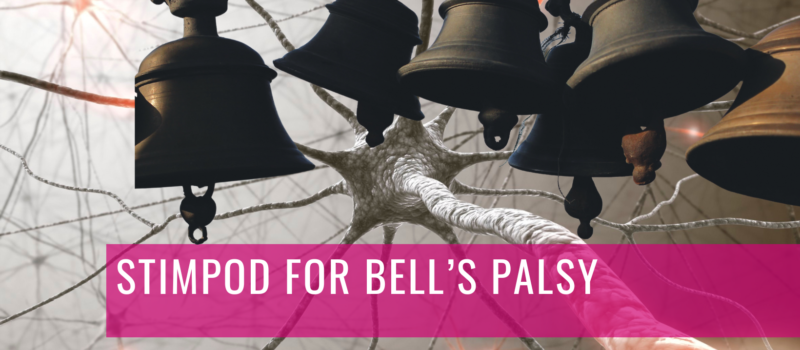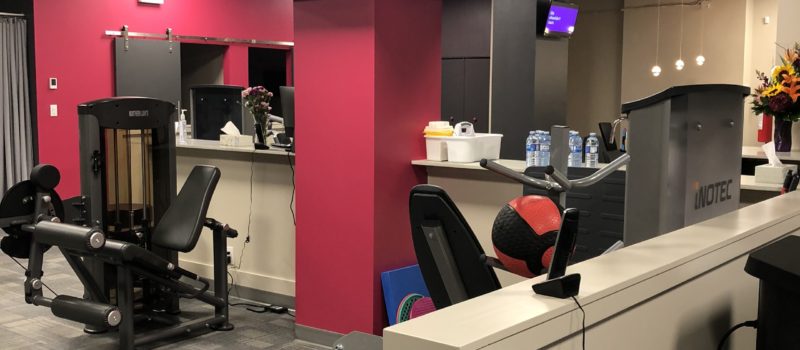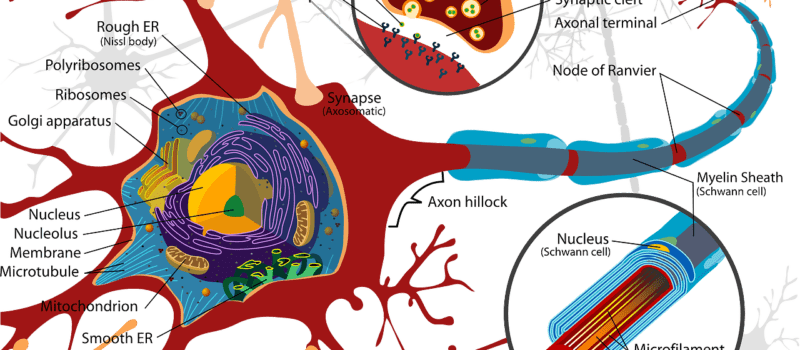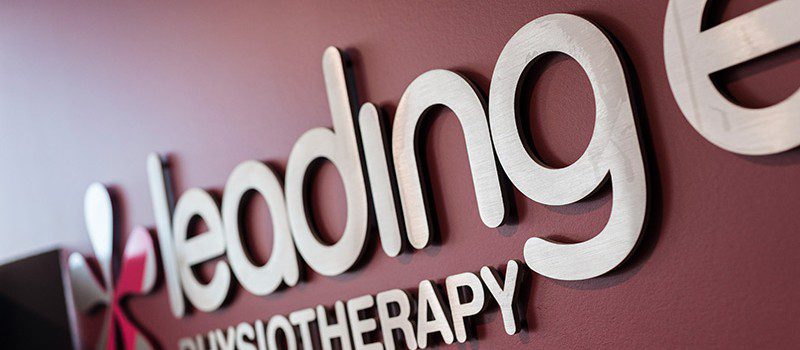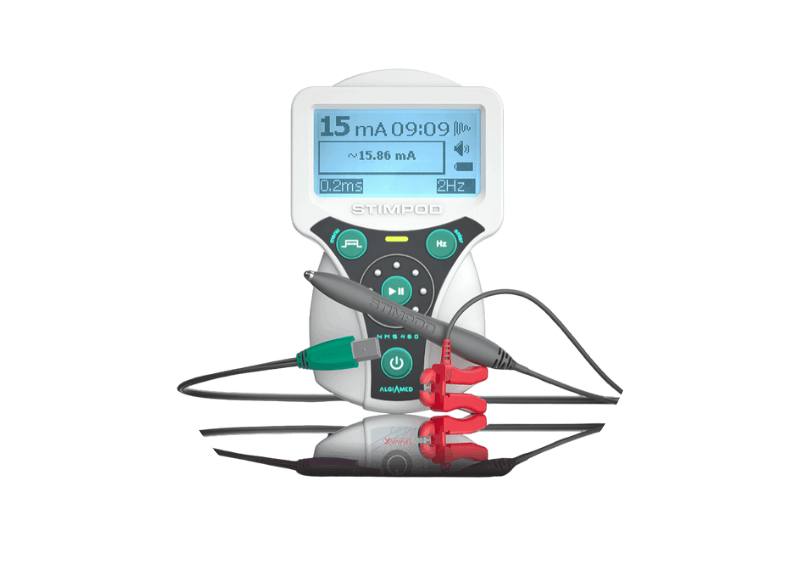
Available at Royal Glenora, Old Strathcona, Tower Sports Medicine Calgary, and University District Calgary locations.
Stimpod (NMS460)
Stimpod is a new technology produced by Algiamed Technologies to assist in the treatment of nerve pain and dysfunction. The Stimpod is noninvasive, and uses a pulsed radiofrequency combined with a low frequency current to locate nerves through the surface of the skin, and stimulates the nerve itself to help reduce symptoms of nerve related pain. Essentially, it sends tiny electric currents through your skin to find and treat nerves that might be causing you pain. It’s like giving your nerves a gentle nudge to help them heal and feel better.
The currents help nerves to heal:
The Stimpod functions by delivering a hybrid waveform that contains both a low-frequency current, which helps to locate the nerve through the skin, and a radio frequency (100-500 kHz) that creates a weak, non-thermal electromagnetic field. While this sounds pretty futuristic, scientists have been utilizing current to manage nerve pain and healing for a long time. This EM field travels along the length of the nerve to its entry point at the spinal cord. It can influence several gene expression markers that regulate inflammation and nerve healing through a metabolic cascade. These markers have been shown to be elevated for up to 14 days following clinical applications of the Stimpod, with reported effects lasting from weeks to months.
A Leading Edge Stimpod Treatment:
Your practitioner will start with a conversation to make sure you are a good fit for treatment with the Stimpod and that there are no reasons you shouldn’t use it. They will ask focused questions about where and what kind of symptoms you have to find the right nerve to target.
Next, you’ll be placed in a comfortable position, and a ground electrode will be put away from the treatment site. A small amount of ultrasound gel will be used on a pen-shaped device to deliver the current through the skin. The machine will be turned on and adjusted to the right level to find the best treatment spot. The pen will be moved until a small muscle contraction is seen for motor nerves or until you feel a moderate pulse for sensory nerves, showing the pen is in the right place.
The practitioner will then adjust to a comfortable level of stimulation, and the treatment will last 5 to 10 minutes. There might be some soreness afterward due to the nerve healing process, but this should pass quickly. After this period, long-term relief from symptoms is expected. You may need several treatments to experience lasting changes in your symptoms. Over time, this can help reduce your pain and make your nerves healthier.
Conditions Treated with the Stimpod NMS460:
- Knee Pain: Helps reduce pain in your knee.
- Back Pain: Eases pain in your back.
- Neuropathy: Treats nerve pain, especially from diabetes.
- Migraines: Helps with severe headaches.
- Sciatica: Relieves pain that travels down your leg.
- Tennis Elbow: Reduces pain in your elbow.
- Chronic Pain: Helps with long-lasting pain.
- Bell’s Palsy: Treats facial nerve pain.
- Radiculopathy: Eases nerve pain in your spine.
- Fibromyalgia: Reduces widespread body pain.
Stimpod is available at many of our Leading Edge Clinics in Alberta. For more information and to book with us for a treatment using this technology, please contact us today!
As your injury will be assessed by and overseen by a registered physical therapist at our facility, the procedure is considered physical therapy and should therefore be covered by third party physical therapy insurance coverage.
Bell’s Palsy is a condition that causes sudden weakness or paralysis on one side of the face. This means that the muscles on one side of your face don’t work as well as they should, making it hard to smile or close your eye on that side.
What Causes Bell’s Palsy?
Bell’s Palsy happens when a nerve in your face gets swollen or inflamed. This nerve controls the muscles of your face, and when it doesn’t work properly, it can cause your face to droop. The exact cause is not always known, but it can sometimes happen after a viral infection, like a cold or the flu.
Symptoms of Bell’s Palsy:
- Sudden weakness or drooping on one side of the face.
- Trouble closing one eye.
- Drooling or difficulty eating.
- Loss of taste on the front two-thirds of the tongue.
- Increased sensitivity to sound in one ear.
What is Neuropathy?
Neuropathy is a condition that affects your nerves. Nerves are like tiny wires in your body that help you feel things and move your muscles. When these nerves get damaged, it can cause pain, tingling, and numbness, especially in your hands and feet.
What Causes Neuropathy?
There are many things that can cause neuropathy, including:
- Diabetes: High blood sugar can damage nerves over time.
- Injuries: Injuries from accidents can harm nerves.
- Infections: Some infections can lead to nerve damage.
- Toxins: Exposure to harmful chemicals can hurt nerves.
- Genetics: Sometimes neuropathy can run in families.
Symptoms of Neuropathy:
- Pain: You might feel sharp or burning pain.
- Tingling: It can feel like pins and needles in your skin.
- Numbness: Parts of your body might feel numb or less sensitive.
- Weakness: Your muscles might feel weak or hard to move.
Oh yah there is… and we have it listed right here for you:
Algiamed Technologies. (2024, May 28). Home | Restoring Hope and Function with tPRF. https://www.algiamed.com/
Berger, P., & Jacks, J. (2014). Report on a case series investigating a neurostimulation device for the treatment of pain and improvement of mobility and function following elbow surgery. Acupuncture and Related Therapies, 2(4), 71–77. https://doi.org/10.1016/j.arthe.2014.10.001
Bonaz, B., Sinniger, V., & Pellissier, S. (2021). Therapeutic potential of vagus nerve stimulation for inflammatory bowel diseases. Frontiers in Neuroscience, 15. https://doi.org/10.3389/fnins.2021.650971
Chang, Y., Chao, Y., & Chang, S. (2024). Feasibility of a promising pulsed electrostimulator for rapid motor recovery of foot drop. Heliyon, 10(3), e25176. https://doi.org/10.1016/j.heliyon.2024.e25176
Chua, N. H. L., Vissers, K. C., & Sluijter, M. E. (2010). Pulsed radiofrequency treatment in interventional pain management: mechanisms and potential indications—a review. Acta Neurochirurgica, 153(4), 763–771. https://doi.org/10.1007/s00701-010-0881-5
Fukui, S. (2013). Intradiscal pulsed Radiofrequency for Chronic lumbar discogenic low back pain: A One year Prospective outcome Study using Discoblock for diagnosis. Pain Physician, 4;16(4;7), E435–E442. https://doi.org/10.36076/ppj.2013/16/e435
Hussain, A., Tauheed, N., Afzal, H., Zafar, L., & Usmani, H. (2019). Noninvasive neuromodulation of supraorbital and occipital nerves as an adjunct to management of chronic headache: A pilot study. Indian Journal of Pain, 33(1), 20. https://doi.org/10.4103/ijpn.ijpn_8_19
Taverner, M. G., Ward, T. L., & Loughnan, T. E. (2010). Transcutaneous pulsed radiofrequency treatment in patients with painful knee awaiting total knee joint replacement. Clinical Journal of Pain, 26(5), 429–432. https://doi.org/10.1097/ajp.0b013e3181d92a87
Taverner, M., & Loughnan, T. (2013). Transcutaneous Pulsed Radiofrequency Treatment for Patients with Shoulder Pain Booked for Surgery: A Double?Blind, Randomized Controlled Trial. Pain Practice, 14(2), 101–108. https://doi.org/10.1111/papr.12059

